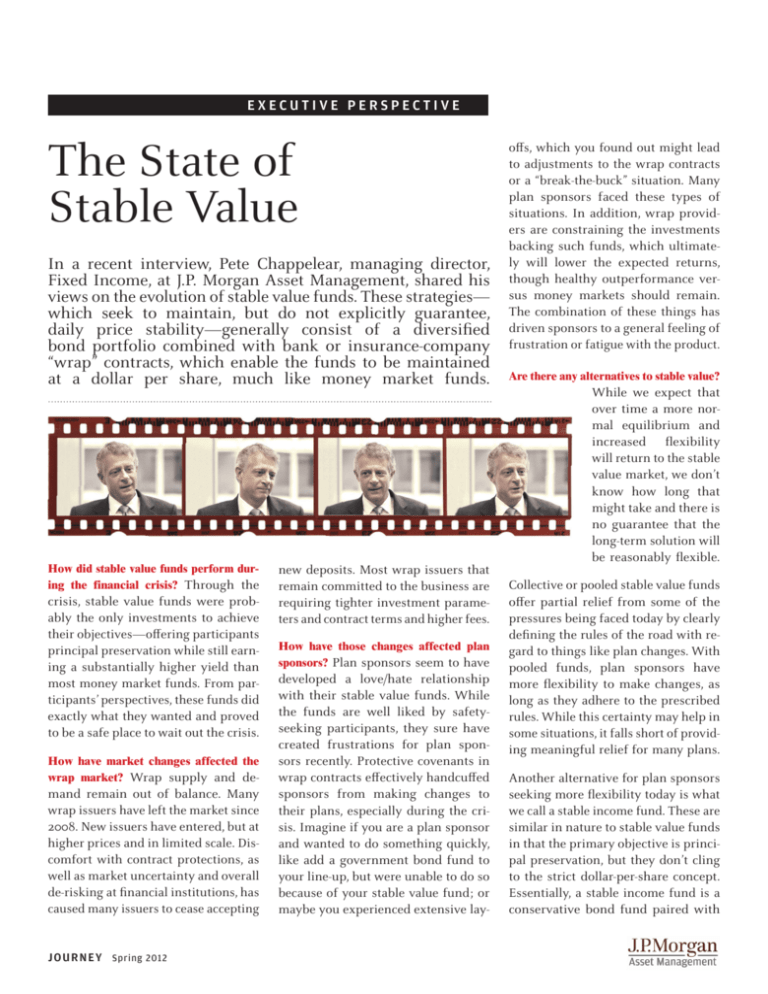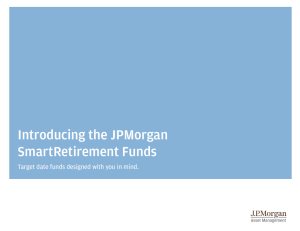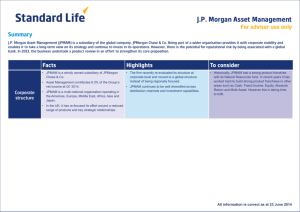
EXECUTIVE PERSPECTIVE
The State of
Stable Value
In a recent interview, Pete Chappelear, managing director,
Fixed Income, at J.P. Morgan Asset Management, shared his
views on the evolution of stable value funds. These strategies—
which seek to maintain, but do not explicitly guarantee,
daily price stability—generally consist of a diversified
bond portfolio combined with bank or insurance-company
“wrap” contracts, which enable the funds to be maintained
at a dollar per share, much like money market funds.
How did stable value funds perform during the financial crisis? Through the
crisis, stable value funds were probably the only investments to achieve
their objectives—offering participants
principal preservation while still earning a substantially higher yield than
most money market funds. From participants’ perspectives, these funds did
exactly what they wanted and proved
to be a safe place to wait out the crisis.
How have market changes affected the
wrap market? Wrap supply and de-
mand remain out of balance. Many
wrap issuers have left the market since
2008. New issuers have entered, but at
higher prices and in limited scale. Discomfort with contract protections, as
well as market uncertainty and overall
de-risking at financial institutions, has
caused many issuers to cease accepting
JOU RN EY Spring 2012
new deposits. Most wrap issuers that
remain committed to the business are
requiring tighter investment parameters and contract terms and higher fees.
How have those changes affected plan
sponsors? Plan sponsors seem to have
developed a love/hate relationship
with their stable value funds. While
the funds are well liked by safetyseeking participants, they sure have
created frustrations for plan sponsors recently. Protective covenants in
wrap contracts effectively handcuffed
sponsors from making changes to
their plans, especially during the crisis. Imagine if you are a plan sponsor
and wanted to do something quickly,
like add a government bond fund to
your line-up, but were unable to do so
because of your stable value fund; or
maybe you experienced extensive lay-
offs, which you found out might lead
to adjustments to the wrap contracts
or a “break-the-buck” situation. Many
plan sponsors faced these types of
situations. In addition, wrap providers are constraining the investments
backing such funds, which ultimately will lower the expected returns,
though healthy outperformance versus money markets should remain.
The combination of these things has
driven sponsors to a general feeling of
frustration or fatigue with the product.
Are there any alternatives to stable value?
While we expect that
over time a more normal equilibrium and
increased flexibility
will return to the stable
value market, we don’t
know how long that
might take and there is
no guarantee that the
long-term solution will
be reasonably flexible.
Collective or pooled stable value funds
offer partial relief from some of the
pressures being faced today by clearly
defining the rules of the road with regard to things like plan changes. With
pooled funds, plan sponsors have
more flexibility to make changes, as
long as they adhere to the prescribed
rules. While this certainty may help in
some situations, it falls short of providing meaningful relief for many plans.
Another alternative for plan sponsors
seeking more flexibility today is what
we call a stable income fund. These are
similar in nature to stable value funds
in that the primary objective is principal preservation, but they don’t cling
to the strict dollar-per-share concept.
Essentially, a stable income fund is a
conservative bond fund paired with
stable value technology, which dampens the price volatility. By wrapping or
stabilizing a meaningful portion of the
fund, say 50% to 70%, the daily price
fluctuations of the fund become quite
muted and, over a relatively short
timeframe like one month or quarter,
the price remains stable. Historical
data shows that a fund structure
with 70% of the assets wrapped
should produce positive returns
on a monthly, quarterly and annual basis, but with daily and
short-term price fluctuations in
the range of three to five basis
points. As Exhibit 1 illustrates,
a stable income strategy would
have roughly the same low volatility as money market and stable
value funds, but with the potential for higher expected returns.
How significant are these changes? From
my perspective, I see product changes
like stable income as game changing.
Stepping away from the confines of a
strict dollar per share product could
be hugely liberating for plan sponsors, and may not be that big a deal
for participants. For plan sponsors,
the structure would give them the
freedom to pursue actions—such as
revamping their DC line-ups or adding target date funds—that would normally be constrained by the traditional
stable value fund. In addition, the fear
of breaking the buck would obviously
“
The combination of
market conditions and
product frustrations
appears to be creating
a favorable climate
for change.
”
go away because participants would
become accustomed to modest daily
price movements. Participants, on the
other hand, would likely view this type
of fund as a safe haven where their
balances would generally remain
protected, much the way they view
stable value or money market funds.
E X H I B I T 1 : C O N S E R VAT I V E A LT E R N AT I V E S W I T H I N A D C P L A N
How committed is J.P. Morgan to
the stable value industry? While
many traditional wrap providers are exiting the business, J.P.
Morgan Asset Management remains firmly committed and is
working to enhance the business for plan sponsors and participants. J.P. Morgan has created
partnerships with leading insurance companies that are bringing
new wrap capacity to market, and
we are making structural changes to
our existing products to ensure continued growth and viability. We expect these efforts, and new product
offerings like stable income, to build
on our position as a market leader.
Pete Chappelear,
managing director
Stable
Value
Return Potential
Despite the many benefits of this type
of fund, we realize it is not for everyone, and that it often takes time for
sponsors that are accustomed to the
dollar-per-share feel of stable value
to consider something somewhat different. That said, the combination of
market conditions and product frustrations appears to be creating
a favorable climate for change.
Bonds
Stable
Income
Money
Market
Volatility
Source: J.P. Morgan Asset Management; diagram for illustrative purposes only.
is a client portfolio manager in
the U.S. Fixed Income Group. An
employee since 1997, Pete is the
head of the firm’s Stable Value
Group, with overall business and
client responsibilities. He currently serves on the Stable Value
Investment Association (SVIA)
Board of Directors. Pete received
his B.A. in economics and
business from Lafayette College.
Stable Value funds are not federally guaranteed and may lose value. Stable Value funds have interest rate, inflation and credit risks that are associated with the underlying assets
owned by the fund. The strength of the “wrap contract” is dependent on the financial strength of the financial institutions issuing the contracts.
Publications referenced in this material are presented for general educational purposes only. JPMorgan and its affiliates did not receive any compensation or consideration for referencing these titles. The opinions and information presented in these titles do not necessarily reflect the opinions of JPMorgan Chase & Co. and its affiliates.
This document is intended solely to report on various investment views held by J.P. Morgan Asset Management. Opinions, estimates, forecasts and statements of financial market
trends that are based on current market conditions constitute our judgment and are subject to change without notice. We believe the information provided here is reliable but should
not be assumed to be accurate or complete. The views and strategies described may not be suitable for all investors. References to asset classes and financial markets are for illustrative purposes only and are not intended to be, and should not be interpreted as, recommendations. Indices do not include fees or operating expenses and are not available for actual
investment. The information contained herein may employ proprietary projections of expected returns as well as estimates of their future volatility. Any forecasts contained herein are
for illustrative purposes only and are not to be relied upon as advice or interpreted as a recommendation. Discussions presented should not be construed as legal opinions or advice.
You should consult your own attorney, accountant, financial or tax advisor or other planner or consultant with regard to your own situation or that of any entity that you represent or
advise. Past performance is no guarantee of future results.
J.P. Morgan Asset Management is the marketing name for the asset management business of JPMorgan Chase & Co. and its affiliates worldwide. IRS Circular 230 Disclosure: JPMorgan
Chase & Co. and its affiliates do not provide tax advice. Accordingly, any discussion of U.S. tax matters contained herein (including any attachments) is not intended or written to be
used, and cannot be used, in connection with the promotion, marketing or recommendation by anyone unaffiliated with JPMorgan Chase & Co. of any of the matters addressed herein
or for the purpose of avoiding U.S. tax-related penalties.
© 2012 JPMorgan Chase & Co. All rights reserved.









